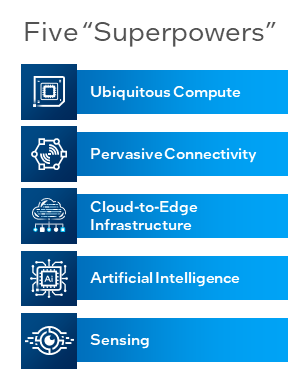View from 2023: Supporting Higher Education Students and Institutions with Optimal Devices and IT Infrastructure
)
Around the world, Higher Education institutions are carrying forward their centuries-old mission: to offer our accumulated human wisdom to new generations of learners ' who will then seek to make their own contributions and improve our world in turn.
That mission and that cycle of learning won't change. What will change -'what has already changed - are the tools we use and the training we offer. Higher education today must provide equitable, engaging, and immersive learning environments - both physically and virtually - to help students develop the mindsets and skill sets they need for a rapidly changing world.
For students, this means weighing a set of considerations around which device to choose. The fact is, different specializations (majors) often require different device characteristics or specifications. For example, students in research-focused'and engineering programs may need higher performance specs than their peers. Similarly, students in design-focused programs (architecture, engineering, interior design, and others) may need to go beyond integrated graphics and choose a device with dedicated graphics support. This goes hand in hand with other considerations, for example, long-lasting batteries to support studying on the go or evaluating whether their device can defend against increasingly sophisticated cyberattacks.
Meanwhile, Higher Education institutions have their own considerations to take into account. While many institutions are working hard to address today's digital challenges, education IT infrastructure remains largely fragmented, and too many solutions live in silos. Amid a rising need for hybrid and high-flex learning, for example, access remains a hurdle. Learners in rural or remote regions often face challenges in accessing lessons or connecting with instructors. Security also remains a top concern. In 2022 in the UK, 92 percent of Higher Education institutions reported having been subject to cyberattacks.1'
Clearly, there is a large and growing menu of IT infrastructure improvements available to institutions. In our view, however, five technologies are essential.

At Intel, we describe these as the 'five superpowers.' They are a quintet comprised of the following: '
Ubiquitous compute'
Gone are the days when 'computer' referred only to monitors and towers. Today, the term applies to everything from PCs to smartphones to wearables and other smart devices. This flexibility creates opportunities for educators (think of a teacher using voice-enabled search to populate a digital white board during a lively class discussion) and administrators (think of content delivery networks, smart security cameras, and smart sensors for facility management).''
Pervasive connectivity
While Wi-Fi is widespread, about a quarter (24 percent) of survey respondents report sometimes having difficulty connecting to course content because of internet issues..2'Soon, however, 5G/6G will allow everything and everyone to be connected, everywhere. Hybrid and high-flex learning will become available for learners in far more places. At the same time, 5G/6G will enable private networks that can provide better responses in remote or rural areas ' and increase protection against cyberattacks.'
Infrastructure
While most educational institutions are familiar with the cloud, very few take advantage of the full Cloud-to-Edge spectrum.
Cloud-to-Edge combines the scale and capacity of the cloud with real-time insights from the edge. This enables the delivery of high-compute applications for specialized classes, streaming content, esports, and other visual workloads.''
AI
Artificial Intelligence (AI) turns infinite data into actionable insights.
For years, educators have weighed AI's potential effects on teaching and learning - and the launch of ChatGPT has intensified that debate. Of course, ChatGPT is just one of many applications of AI.
AI will enable much more. When used effectively and responsibly, it will boost educators' ability to drive higher student outcomes. AI will also offer a truly adaptive experience based on each learner's individual capacity, learning style, and interests.
In addition, AI will be at the center of smart campuses, with video analytics for physical security and optimized facility management.''
Sensing
Sensing is the fifth superpower.
Sensing technology enables us to augment and emulate all five human senses, connecting the real world with the virtual world ' and expanding our capacity to collaborate.'
At Intel, we envision many applications of sensing technologies on campus, including smart sensors for air quality, air conditioning, lighting, security - even robotic lawnmowers.''
Bringing It All Together: Leveraging Institutional Resources to Advance Student Learning
Student device selection matters. So do institutions' choices about how to upgrade their infrastructure to support cutting-edge learning experiences.
We're great advocates of sharing classroom-ready academic programmes to demystify the technologies of the future. We're also going further, partnering directly with institutions to develop future-focused curricular and training programs. For example, Intel has teamed up with China's Wuhan University of Technology to develop a new engineering curriculum'that blends research with collaborative education and prepares students for tomorrow's innovation ecosystem. By increasing the proportion and depth of experimental practice, the university is committed to laying a solid foundation for the development and growth of new engineering talent.
In addition, we're investing significant resources in our AI for Workforce'program and partnering with other organizations to fund AI labs in community colleges'across the United States. The funding will enable the winning schools to build AI labs that will provide students with more access to AI tools and resources to meet the computing needs of the AI for Workforce program course load. We've also offered digital readiness training to over 4 million young people in 27 countries, with a goal of 30 million in 30 countries by 2030. These programs promote a deep understanding of AI, provide access to AI toolsets, and create meaningful social impact solutions.'
At Intel, we are committed to supporting both students and institutions on the path to optimal learning experiences. Check out our Higher Education'website to discover more on how we can provide support and offer advice.
About Intel
As an active education supporter and trusted industry partner, Intel works closely with everyone involved in the educational ecosystem to help shape the future of education technology, drive innovation in education, and deliver equitable EdTech solutions that meet the needs of all students'no matter how or where they learn. Learn more at intel.com/education.
- 'How to prepare and protect your institution against a future cybersecurity attack,' Times Higher Education, accessed 22 March 2023 'https://www.timeshighereducation.com/campus/how-prepare-and-protect-your-institution-against-future-cybersecurity-attack
- 'Online Isn't Optional: Student Polling on Access to Internet and Devices,' Institute for Higher Education Policy, accessed 5 April 2023. https://www.ihep.org/publication/online-isnt-optional/
 This article was written by Jorge Rodriguez, Global Education Sales Strategy,'Intel Corp. Mexico. Jorge has 12 years of experience working with governments and educational institutions within the technology field. He has supported multiple countries with the development of their Digital Readiness strategies, integrating Intel Education skills development programs'such as 'Intel Skills for Innovation' and 'AI for Youth'. Jorge is a proud Geek and an esports enthusiast; he is always looking for ways to integrate new technology trends into educational use cases in order to add value to the students' present experience and their future professional needs.
This article was written by Jorge Rodriguez, Global Education Sales Strategy,'Intel Corp. Mexico. Jorge has 12 years of experience working with governments and educational institutions within the technology field. He has supported multiple countries with the development of their Digital Readiness strategies, integrating Intel Education skills development programs'such as 'Intel Skills for Innovation' and 'AI for Youth'. Jorge is a proud Geek and an esports enthusiast; he is always looking for ways to integrate new technology trends into educational use cases in order to add value to the students' present experience and their future professional needs.
LinkedIn: Jorge Rodr'guez Vargas
'


)
)
)
)
)
)
)
)
)